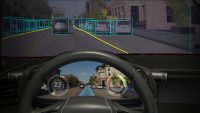Voice Tech Adoption Reaches Beyond Smart Homes to Autos
January 18, 2019
Together, Amazon and Google claim about 85 percent of the smart speakers currently installed in U.S. households. In the wake of a successful holiday shopping season, the number of smart speakers in the U.S. has climbed to around 119 million. And while Amazon and Google battled for dominance at CES with voice assistant support featured in a growing array of devices and services, a new survey from Voicebot.ai suggests that voice assistants may be more habit-forming in vehicles than via smartphones. The voice tech publication found that 77 million adults use such assistants in their vehicles at least monthly, and companies are taking notice.
By comparison, the Voicebot survey found that 45.7 million adults use voice assistants on their smart speakers. There are a few reasons for this difference in numbers:
“Way more people own cars than smart speakers,” explains Recode. “Voice tech in cars has been around since 2004 when IBM launched voice-controlled navigation in Hondas — giving it a decade’s head start over smart speakers (Alexa was released in 2014).” Additionally, vehicles “are arguably one of the best use cases for voice technology, since driving prohibits — or should, at least — people from using touchscreens.”

Since smartphones have near universal adoption — and assistants such as Siri and Google Assistant are featured in iPhones and Android phones, respectively — more than 90 million consumers access the assistants at least once a month. However, Voicebot suggests that car voice tech may be more habit-forming.
“Of those who’ve used voice assistants in their cars, 68 percent do so monthly,” notes Recode. “That’s compared with 62 percent monthly usage among smartphone voice assistant users. Smart speakers have the highest rate of voice assistant monthly usership — 79 percent — but that’s not surprising as voice is the only way with which to communicate with speakers.”
As the popularity of voice tech continues to grow, automotive should become a major market sector. And an increasing number of today’s cars are rolling off the assembly lines featuring built-in versions of Apple’s CarPlay or Android Auto. Google Assistant support was unveiled for a number of vehicle devices on display at CES — including JBL’s $60 Link Drive and Anker’s $50 Roav Bolt — and Amazon debuted Echo Auto in September (its in-vehicle accessory that makes it easier to integrate Alexa into any automobile, regardless of whether the automaker included voice tech support).

According to Digital Trends (which published an extensive list of Alexa-supported products at CES), Amazon’s voice assistant will appear via dashboards, infotainment and navigation systems through new offerings from companies such as Abalta, Boss Audio, Luxoft, Qualcomm, Telenav and others.
In addition to new autonomous vehicles and the integration of voice tech, the automotive booths at CES 2019 featured companies aiming to make vehicles smarter with a variety of solutions. Samsung, for example, is looking to bring its virtual assistant Bixby to cars. At CES, the company announced its updated 2019 Digital Cockpit, a collaboration with subsidiary Harman, that promises to deliver more intelligence through AI and onboard cameras that recognize drivers and passengers to manage seating, lighting, audio and various safety features.
“Thanks to new integrations,” reports VentureBeat, “Samsung says that Bixby can, with a Digital Cockpit-equipped car, do things like report fuel levels and set the temperature on command.” Unlike Amazon’s aftermarket solution, “Bixby is built into cars with the Digital Cockpit.”
Nvidia introduced its Drive AutoPilot at CES, which TechCrunch describes “a reference platform that automakers can use to bring more sophisticated automated driving features into their production vehicles.”

The Drive AutoPilot system offers over-the-air software updates and intends to improve advanced driver assistance systems. “It enables highway merging, lane changes, lane splits, pedestrian and cyclist detection, parking assist, and personal mapping as well as in-cabin features like driver monitoring, AI copilot capabilities, and advanced in-cabin visualization of the vehicle’s computer vision system.”
During its CES press conference, Qualcomm announced its third-gen Snapdragon Automotive Cockpit Platform, the company’s “latest AI-centric platform for building in-car experiences that include everything from voice-driven interfaces to good-old navigation systems, all with modern visual interfaces,” notes TechCrunch. The platform “includes the Qualcomm Hexagon Processor, an accelerator for running machine learning models for use cases like natural language processing and object classification, as well as Qualcomm Vision camera sensors and computer vision hardware.”
Related:
The Holidays Ushered In a Smart Speaker Explosion Starring Amazon’s Alexa and Google’s Assistant, Recode, 1/8/19
With New Integrations, Google Assistant Makes Big Push for Dominance at CES 2019, Digital Trends, 1/8/19
The Race to Create the Coolest Smart Home Devices Is Hotter Than Ever, The New York Times, 1/15/19
The Best Car Tech of CES 2019, ExtremeTech, 1/11/19

No Comments Yet
You can be the first to comment!
Sorry, comments for this entry are closed at this time.